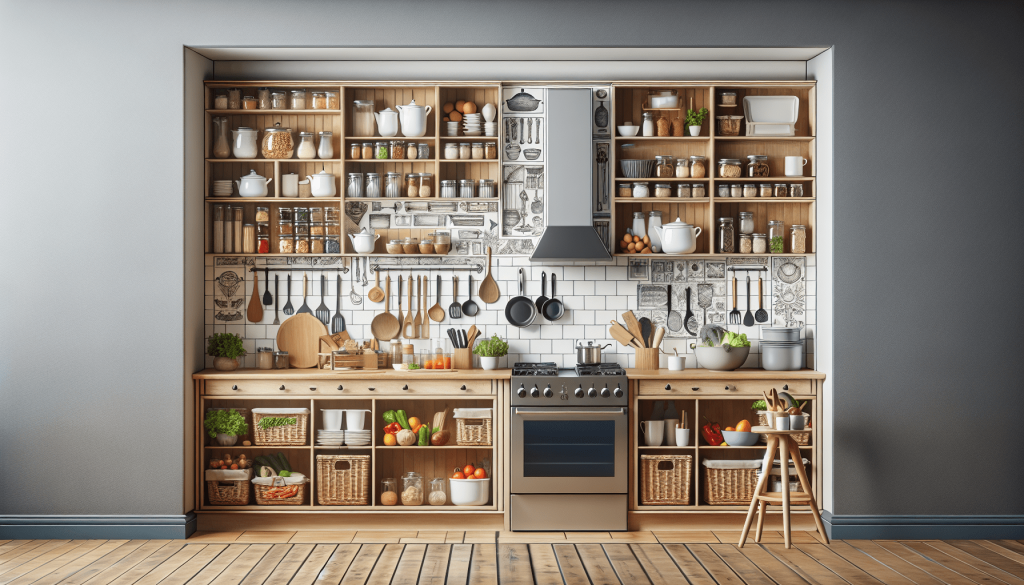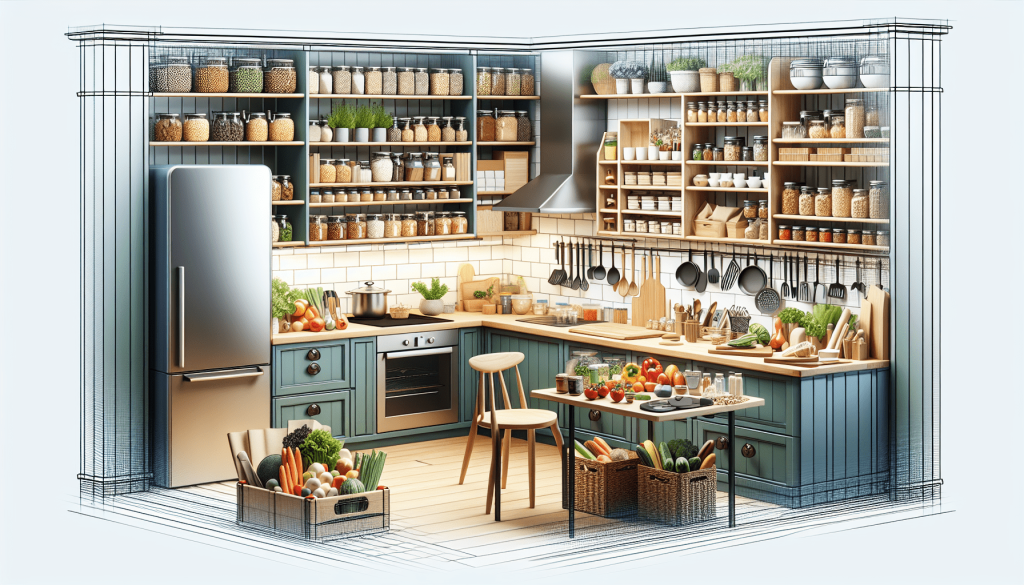So, you’ve decided to jump on the meal prepping bandwagon and give your busy life a little more structure and sanity. But where do you begin? Well, it all starts in the heart of your home – the kitchen. Creating an efficient and organized kitchen is the key to successful meal prepping, and in this article, we’ll walk you through some simple yet effective tips and tricks to help you whip up delicious and healthy meals in no time. From decluttering your pantry to strategically arranging your cooking tools, get ready to transform your kitchen into a meal prepping haven. Let’s get started, shall we?

Clearing and Cleaning
Decluttering your kitchen
Before you can begin organizing your kitchen for meal prepping, it’s important to start with a clean and clutter-free workspace. Begin by going through your cabinets, drawers, and pantry to remove any unused or expired items. Clear out any dishes, appliances, or utensils that you no longer use or need. By decluttering your kitchen, you’ll create more space and make it easier to find the essentials for meal prepping.
Cleaning your kitchen
Once you’ve decluttered your kitchen, it’s time to give it a thorough clean. Start by wiping down all surfaces, including countertops, cabinets, and appliances. Pay special attention to areas that are prone to accumulating crumbs or spills, such as around the stove and sink. Don’t forget to clean your refrigerator and freezer as well, removing any expired or unwanted food. A clean kitchen creates a fresh and inviting environment for meal prepping.
Assessing Your Kitchen Space
Evaluating available storage space
Before you can begin organizing your kitchen for meal prepping, it’s important to assess the available storage space. Take a look at your cabinets, drawers, and pantry to see how much room you have to work with. This will help you determine the best storage solutions for your kitchen and ensure that everything has its place.
Identifying suitable areas for meal prepping
In addition to storage space, it’s important to identify suitable areas for meal prepping in your kitchen. Look for large countertops or islands that provide ample workspace for chopping, slicing, and preparing ingredients. By designating specific areas for meal prepping, you’ll be able to streamline your cooking process and make it more efficient.
Investing in Storage Solutions
Stocking up on airtight containers
Investing in airtight containers is a game-changer when it comes to meal prepping. These containers help keep your ingredients fresh and extend their shelf life. It’s important to choose containers that are both practical and stackable, so they can fit neatly in your pantry or refrigerator.
Using clear jars for ingredient storage
Clear jars are not only aesthetically pleasing but also a practical solution for storing ingredients. They allow you to see at a glance what you have on hand, making it easier to plan your meals and prevent waste. Invest in a variety of sizes to accommodate different ingredients, such as grains, nuts, and spices.
Utilizing stackable storage bins
Stackable storage bins are another great addition to your kitchen organization. They provide a versatile solution for categorizing and storing items, such as baking supplies, snacks, or canned goods. By utilizing these bins, you’ll maximize your storage space and create a tidy and accessible pantry.
Creating Zones
Designating areas for different tasks
Creating zones in your kitchen can help streamline your meal prepping process. Dedicate specific areas for different tasks, such as meal planning, food preparation, and clean-up. This will help you stay organized and ensure that everything is easily accessible when you need it.
Setting up a food prep zone
Having a designated food prep zone will make meal prepping a breeze. Set up an area where you can comfortably chop, slice, and dice your ingredients. Keep essential tools and utensils within arm’s reach, making the process of meal prepping efficient and enjoyable.
Organizing a storage zone for prepped meals
After you’ve finished meal prepping, it’s important to have a designated storage zone for your prepped meals. This can be a section of your refrigerator or freezer, or even a separate cabinet or shelf. By keeping your prepped meals in a specific area, you’ll be able to find them easily and avoid any accidental mix-ups.

Arranging Pantry Essentials
Categorizing pantry items
When organizing your pantry, it’s helpful to categorize your items. Group similar items together, such as grains, canned goods, and snacks. This will make it easier to find what you need and prevent items from getting lost in the back of the pantry.
Labelling containers and jars
Labelling containers and jars is a simple yet effective way to stay organized. Use adhesive labels or a label maker to clearly mark the contents of each container. Not only will this prevent confusion, but it will also add a touch of orderliness to your pantry.
Arranging items by frequency of use
To optimize your pantry space, arrange items according to their frequency of use. Keep frequently used items at eye level or within easy reach, while less frequently used items can be stored on higher or lower shelves. This will make it easier to quickly find what you need and maintain a sense of order in your pantry.
Streamlining Utensil and Tool Storage
Identifying essential tools
When it comes to utensil and tool storage, it’s important to identify the essentials. Keep items that you regularly use within easy reach, while less frequently used gadgets can be stored in a separate drawer or cabinet. By streamlining your utensil and tool collection, you’ll reduce clutter and make it easier to find what you need.
Investing in drawer organizers
Drawer organizers are a practical solution for keeping your utensils and tools neatly arranged. Use dividers or trays to separate different types of utensils, such as spatulas, whisks, and tongs. This will prevent them from getting tangled or mixed up, making it easier to locate the specific utensil you need.
Hanging utensil racks or magnetic strips
If you’re short on drawer space, consider hanging utensil racks or magnetic strips on your kitchen walls. This will free up valuable drawer space and add a decorative element to your kitchen. Hang frequently used utensils within easy reach for quick and convenient access.
Optimizing Refrigerator and Freezer Space
Clearing out expired and unwanted food
Regularly clearing out expired or unwanted food is essential for maintaining a clean and organized refrigerator and freezer. Take the time to check expiration dates and discard any items that have gone bad. This will prevent unpleasant odors and free up valuable space for your meal prepped items.
Using fridge and freezer organizers
Utilizing fridge and freezer organizers can significantly maximize your storage space. Invest in clear plastic bins or trays to categorize items and prevent them from getting lost or buried. These organizers will help you maintain order and make it easier to find what you need quickly.
Creating a meal prepping inventory system
To stay organized and keep track of your meal prepped items, it’s helpful to create a meal prepping inventory system. Keep a list or a whiteboard on your refrigerator that tracks what meals you have prepared and when they were made. This will help you plan your meals efficiently and prevent any wastage.
Utilizing Vertical Space
Installing wall-mounted shelves
When it comes to vertical space, installing wall-mounted shelves can be a game-changer. These shelves provide additional storage for items that you don’t use on a daily basis, such as large pots or kitchen appliances. Utilize this space to keep your kitchen countertops clear and create a more visually appealing kitchen.
Hanging hooks for utensils or pots
If you have limited cabinet space, hanging hooks can be a lifesaver. Install hooks on your kitchen walls for hanging utensils, pot holders, or even pots and pans. This not only adds a decorative touch to your kitchen but also frees up valuable cabinet space for other items.
Using a pegboard for tool organization
A pegboard is a versatile and practical solution for organizing your kitchen tools. Install a pegboard on an empty wall and hang your tools on it using hooks or pegs. This allows you to easily see and access your tools, keeping them organized and within easy reach.
Labeling and Dating
Using labels for containers and jars
Labeling your containers and jars is a simple yet effective way to maintain order in your kitchen. Use adhesive labels or a label maker to clearly mark the contents and expiration dates of your containers. This will prevent any confusion and help you quickly identify what you need.
Implementing a date system for meal prepped items
To ensure that your meal prepped items stay fresh and organized, implement a date system. Use small stickers or permanent markers to label the date each meal was prepared. This will help you prioritize which meals to consume first and prevent any wastage.
Maintaining Order
Consistently decluttering and cleaning
To maintain the order and organization in your kitchen, it’s important to consistently declutter and clean. Set aside some time each week to go through your cabinets, drawers, and pantry, removing any unused or expired items. Additionally, make it a habit to wipe down surfaces and clean your appliances regularly to keep your kitchen looking its best.
Reevaluating organization periodically
As your cooking and meal prepping needs change, it’s important to periodically reevaluate your organization system. Take the time to assess whether your current setup is still working for you or if any adjustments need to be made. This will help ensure that your kitchen remains efficient, organized, and tailored to your needs.
By following these helpful tips and dedicating some time to organize and declutter your kitchen, you’ll create a more efficient and enjoyable space for meal prepping. Remember, a well-organized kitchen is the foundation for successful and stress-free meal preparation. Happy organizing!
